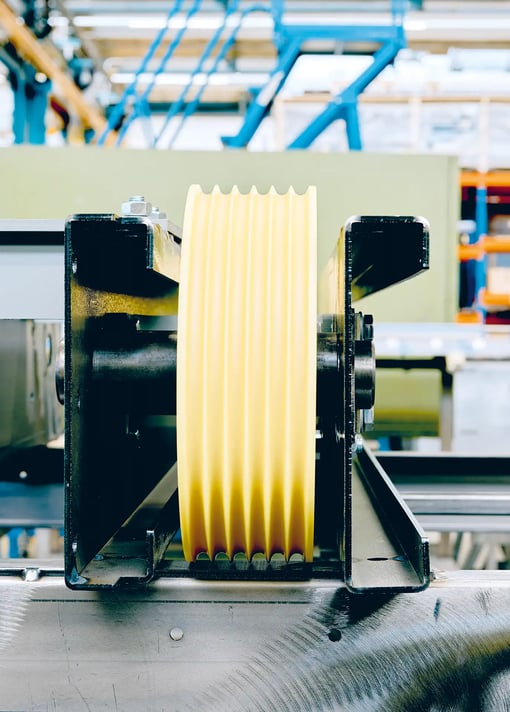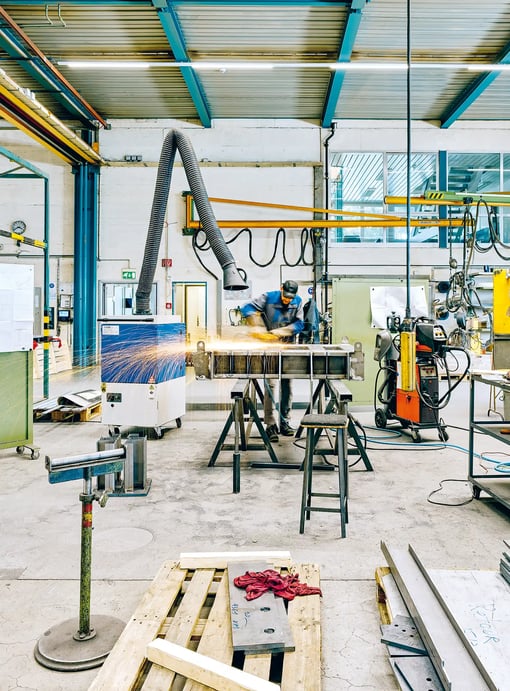To date, sustainability in lift construction seems to have focused on reducing energy consumption during operation and creating more efficient drive systems. The major manufacturers offer regenerative drives, energy storage, stand-by modes, optimization of travel and waiting times, and energy-efficient lighting. It is often forgotten that the entire life cycle of a product counts for the CO2 balance: from production to installation and operation to maintenance.
The most important factor is production, which necessarily costs energy and materials, and emits CO2 accordingly. Therefore, the greatest contribution to a more sustainable elevator is to enable the longest possible service life: even the most energy-efficient elevator is not very sustainable if it is dismantled and completely replaced after 20 years - the average life expectancy of a standard wire rope elevator with a counterweight. „The most efficient lift is the one that remains in the building for as long as the building stands, ideally more than 100 years,“ says Daniel Steiger, Sales Manager at Emch and architect. This is also the company‘s philosophy: to rely on robust and durable systems and to prefer a repair to a replacement.

The rope pulley is designed so that bearings can be easily replaced.

Individual rather than mass production ensures quality and a long service life.
Bucking the trend
An elevator is already suitable for the circular economy today - without any major development effort. The service life of the individual parts varies greatly: wearing parts such as drives or ropes need to be replaced more frequently than less stressed elements such as guide rails, support frames or counterweights, which, with appropriate maintenance, have an almost unlimited service life.
To maximize service life, every component must be easy to repair or replace. This requires a modular design, but the trend is moving in the opposite direction: elevators today are less modular than in the past. Similar to developments in the automotive or electrical industries, lift systems are built as closed, standardized products whose individual parts cannot be replaced easily. This is also due to the fact that the models are type-tested and certified as a whole. As a result, elevator systems may have to be completely replaced, even if only one component is defective - for example, because the spare part is no longer produced for precisely this model.
Scope for spare parts
Emch is setting a counter-trend in production: the components of an elevator are put together individually in order to be able to respond to the specific requirements of a custom-made product. Thanks to the ease with which the components can be dismantled and the separate certification of the individual elements, the company is already thinking about subsequent repairs or retrofitting during production. Therefore, an Emch elevator does not undergo a model examination. Instead, the certificate of conformity is issued on the basis of individual testing and acceptance. This not only makes it possible to replace components according to their service life without any problems, but also to use components from other suppliers. This provides more leeway when procuring spare parts and allows adaptation to stricter standards.
The principles of modularity that apply to Emch‘s custom-made products could also be applied to the standard lifts from the major manufacturers. If the components of standardized products could also be replaced according to their respective service lives, this would significantly extend the service life of elevator systems. However, this requires a rethink on the part of both manufacturers and users. The goal must not be the latest standard or trend, but as many life cycles as possible.
In addition to the lack of modularity, new standards or trends also lead to the premature replacement of an elevator system. Another reason is changes in the usage requirements of a building. Additional storeys, basements or higher load requirements can call into question the maintenance of existing elevator systems. Here too, Emch shows what is possible. At a chemical company in Arlesheim, a 40-year-old freight elevator system had to be retrofitted to increase the transport load and travel speed. In addition, the old swing doors needed to be replaced with automatic door systems. Emch reinforced the existing lift structure and adapted it to the new requirements. Additional rail brackets guaranteed meeting the new earthquake safety requirements. Many materials could be reused, including the 4000-kilogram counterweight, which was extended and supplemented in order to compensate for the higher payload.
The challenge of accessibility
The standardization of building components offers great potential for their reuse. Nevertheless, flexible special solutions will continue to play an important role, especially in the careful conversion of historical and existing buildings. Many older buildings need to be converted to ensure accessibility. The lack of a lift or anticipated difficulties during the installation of a new lift can be a reason to demolish the existing building. Creative and economical solutions are therefore required.
On several occasions already, Emch has succeeded in avoiding invasive interventions into the building fabric by using special solutions. True to the motto „leave no trace“, the company has often worked with self-supporting shaft structures. It is currently developing a system in which the elevator car functions as a counterweight. This space-saving solution has the potential to help many older residential buildings survive longer. A sustainable lift has a modular structure, is designed to save space and is adaptable in use. It is robust, durable, repairable and reusable. Additionally, an old lift is sustainable if it is carefully modernized. This requires clients and companies who understand the appeal and necessity of building onto existing structures.

